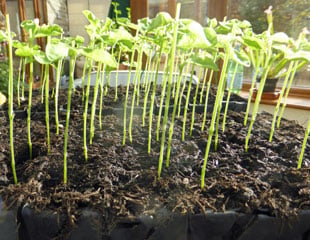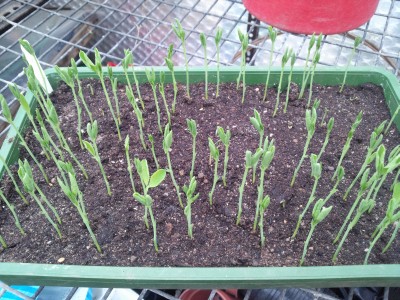The nights are dark, the frost and snows are coming, plants are dead or dying and the garden is chock-a-block with fallen leaves. Yet, this is one of the best times for dreaming about the glorious array of plants that are available for next year.
 Go into the garden, just before twilight and imagine the colours, the smells and the sounds. Close your eyes and let your imagination take over.
Go into the garden, just before twilight and imagine the colours, the smells and the sounds. Close your eyes and let your imagination take over.
Over there, against the fence or the neighbour’s wall, there is a fragrance so attractive that it’s intoxicating.
Yes, it is sweet pea, or as the Royal Horticultural Society likes to call it, Lathyrus odoratus. Whatever name you like to use – and a growing number of gardeners do use the botanical names – it is blooming wonderful (sorry about the pun).
The sweet pea should have a wonderfully exotic name like “angels’ wingspans” or “ballerina’s costume”. But no, it is common old “sweet pea.” There’s something comfortable about turning up at someone’s house for a visit and giving them a bouquet of fresh-cut sweet peas. Many presentations of flowers convey different sentiments; sweet peas are one of those flowers that say you are a true friend.
Despite its very ordinary name it is one of the nation’s favourite cut flowers, if not THE favourite. It has longevity of flowering (as long as you continually cut the flower to help new growth), it has that heady aroma, it looks wonderful with the ranges of colours, and best of all it’s easy to grow.
Seize the Day
 And now, when the garden is at one of its lowest ebbs in the growing year, is the best time to start off sweet peas, knowing they will almost certainly flourish.
And now, when the garden is at one of its lowest ebbs in the growing year, is the best time to start off sweet peas, knowing they will almost certainly flourish.
“The advantages accruing from sowing sweet peas in the autumn are so real and substantial that there should be no need for argument,” wrote the renowned Amateur Gardener editor A.J. Macself back in 1933. Sweet pea experts agree that autumn is the best time to sow.
Wild sweet peas originate in Sicily where the summers are dry and the autumn rains initiate seed germination. During the winter their roots head deep into the soil but top growth develops slowly. Stem growth speeds up in spring, flowering takes place in May and June and seed ripens in the dry season. So sweet peas are naturally adapted to this autumn-to-summer cycle.
Better than Spring
 Sowing seeds in the autumn ensures that by March or April, plants already have bushy top growth and extensive root systems just at the time when many gardeners are sowing their seeds.
Sowing seeds in the autumn ensures that by March or April, plants already have bushy top growth and extensive root systems just at the time when many gardeners are sowing their seeds.
The spring-sown plants never catch up. Autumn-sown plants are more vigorous and more resilient in dry conditions, they flower for longer and the flowers are larger.
Sweet pea exhibitors will tell you that the quality of the individual blooms is better. For best results sow seeds in deep pots or root trainers as the open ground is too much of a gamble and trays are too shallow.
The roots will have plenty of depth to grow and, when planting, there is little or no disturbance as each block of cells is hinged in the root trainers for easy removal of the plants. The keys to success with both methods are to ensure that the roots of the young plants are never waterlogged and that the seedlings are kept in good light, are sheltered from the worst of the weather and are protected from slugs and mice.
A cold frame was traditionally seen as the ideal location for germination and growth but these have all but vanished. Seeds can be started in a cold greenhouse but temperatures can rise dramatically on sunny days. The site at the base of a west or south wall or fence works well and remember to stand pots on gravel to encourage good drainage. Good growing!
by Bob Graham
The post Gardening: It’s Time To Plant Sweet Pea Seeds appeared first on Felix Magazine.
No comments:
Post a Comment